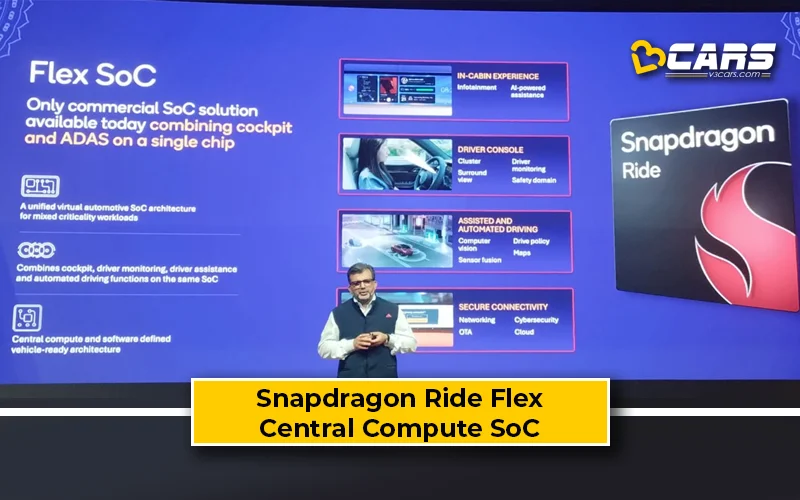Future-Ready Snapdragon Ride Flex SoC Pitched By Qualcomm At Auto Day | V3Cars
Qualcomm recently hosted the Snapdragon For India — Auto Day event in Delhi, where they brought together auto industry experts, thought leaders and policy makers to make their case for Software Defined Vehicles (SDV). With an SDV architecture, the cars can continue to get updates and new features years after the purchase. At the event, Qualcomm officials presented the idea of central compute using their next-generation Snapdragon Ride Flex.

Currently, even the top of the line automotive grade SoCs from Snapdragon manage the infotainment, entertainment and information on the instrument cluster using the Snapdragon Cockpit. Meanwhile, drive controls, such as shifter, braking (both, foot brakes and parking brakes), accelerator and steering fall under the scope of the Snapdragon Ride line of SoCs. That means, the ADAS is managed using the Snapdragon Ride as it receives information from the cameras, radars and sensors and translates these inputs while driving itself or assisting the driver.
With the Ride Flex architecture, they intend to merge the two functionalities — in cabin digital experience and drive controls — remain on separate compute chips/SoCs. The merger of these tasks will help manufacturers simplify their wiring and lower the costs as they will only need one chip instead of two.
The fact worth noting here is that, currently, only a few manufacturers are even employing this system, which is quite advanced. Most cars have a distributed compute, where a bunch of ECUs are required to handle various functions. The next level of upgrade for such vehicles would be with zonal architecture where one SoC performs the job of a bunch of ECUs but there still remain more than half a dozen SoCs in the car.
The important thing to note is that this is not something too far into the future. Qualcomm already have the Flex SoC in production. As demand & acceptance for this SoC grows, we can expect them to scale up the production. While it may be too much for a car these days, making the processors future ready will allow the carmakers to deliver the improved experience even to some of their older cars. Moreover, even as the lines of code add up, having a computing superpower in the car means that the manufacturer can afford to keep updating the older cars for more than half a decade. Perhaps even longer.
In terms of capabilities, the Flex SoC has 3 times more CPU and GPU. On the AI side, its NPU capabilities are 12 times better than the previous generation Ride or Cockpit chips for offline AI capabilities. We can start to see such powerful processors more commonly in cars in the next 5 years or so. The auto industry is quite slow to adopt changes as drastic as swapping out whole wiring and processing architecture.
Also Read: Top 20 Revolutionary Features Of 2025 Mahindra XEV 9e & BE 6
Helpful Links:
Fuel Cost Calculator for Cars – Know your monthly fuel expense based on usage and mileage
Car On-Road Price Calculator – Convert ex-showroom to on-road price for any city
Sell Used Car Online – Enter your car and contact details to get an instant price estimate and book a free inspection with our partner network


0 Comments